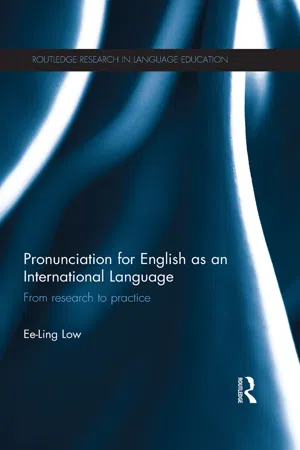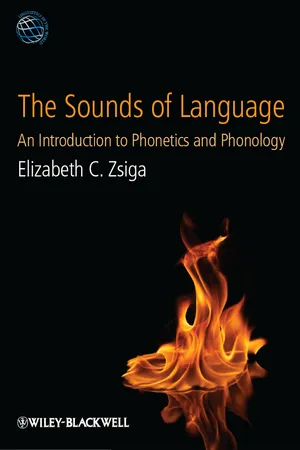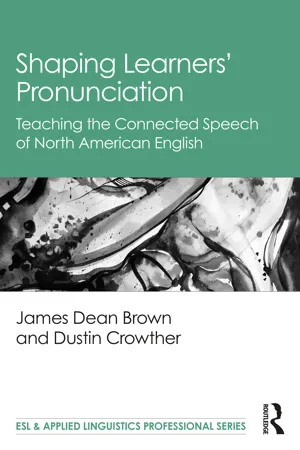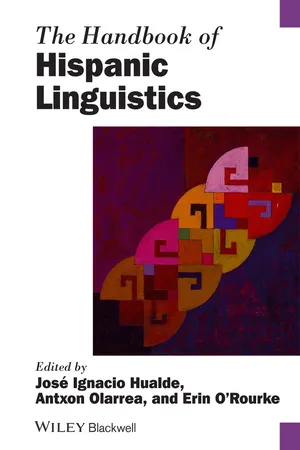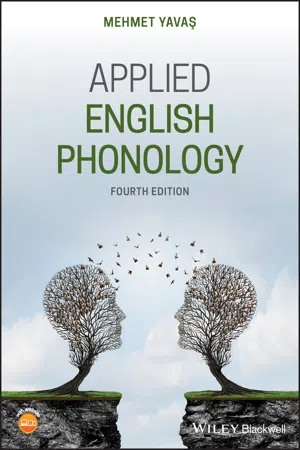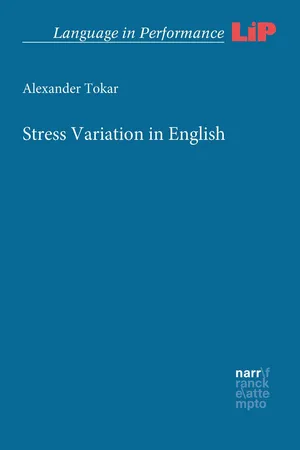Languages & Linguistics
Stress of a Word
The stress of a word refers to the emphasis or prominence placed on a particular syllable within the word. In many languages, including English, the stress pattern can change the meaning or grammatical function of a word. Understanding stress patterns is important for proper pronunciation and comprehension in spoken language.
Written by Perlego with AI-assistance
10 Key excerpts on "Stress of a Word"
- eBook - ePub
Pronunciation for English as an International Language
From research to practice
- Ee-Ling Low(Author)
- 2014(Publication Date)
- Routledge(Publisher)
7 Stress DOI: 10.4324/9781315814131-7This chapter will first provide an overview about what constitutes stress and go on to talk about lexical (word) stress and sentence stress. It will then provide an extensive overview of recent research on stress patterns found in different varieties of English. Finally, the implications of the research findings for EIL pronunciation teaching will be discussed.Basic concepts
What is stress?
Low (1998) has given a thorough coverage of what is stress from the research literature and the two main approaches to the treatment of stress: the phonetic treatment and the linguistic or phonological treatment of stress. The main arguments will be surfaced here and updated with more recent literature on the topic.Phonetic treatment of stress
Within this approach, it is important to bear in mind the speaker’s perspective (the articulatory aspect of stress), the hearer’s perception (the auditory aspect) and the instrumental measurement of stress (its acoustic correlates). From the articulatory perspective, stress has been associated with increased force. Jones (1962) defines a stressed syllable as being uttered with greater effort compared to its surrounding syllables. This greater force was associated with increased activity of the expiratory muscles, where stressed syllables corresponded to stronger chest pulses (Stetson, 1951 ). Researchers later concluded that not every syllable has a concomitant chest pulse and that the action of respiratory muscles alone is not a reliable cue to stress (Ladefoged, 1967 ; Ohala, 1977).Those who believed that stress involves an increase in muscular effort also advocated the view that, perceptually, stress leads to an increase in loudness or intensity and is measured by an increase in amplitude. Some researchers even advocated that intensity is the primary component accounting for stress such as Pike (1945) , Malmberg (1963) and Crystal (1969) . However, Crystal (1969 , p. 158) also defines stress as being accompanied by pitch movement measured as F0 apart from just an increase in loudness. With pitch coming into the picture, the debate about whether the larynx or the lungs were responsible for pitch movement became the new point of controversy. The general consensus reached was that it was the larynx, not the lungs, which was mainly responsible for F0 variations (Ohala, 1977 ; Ohman & Lindqvist, 1966 ; Vanderslice, 1967 - eBook - ePub
The Sounds of Language
An Introduction to Phonetics and Phonology
- Elizabeth C. Zsiga(Author)
- 2012(Publication Date)
- Wiley-Blackwell(Publisher)
stress systems . The definition and uses of linguistic stress are discussed in Section 16.1. Section 16.2 surveys the different kinds of stress systems found in the languages of the world, and 16.3 lays out the reasons why a feature [+/− stress] is inadequate to cover the data. Section 16.4 then introduces the hierarchical grid and tree structures that have been proposed to account for stress patterns, and introduces different types of metrical feet. Section 16.5 concludes with a discussion of the complex stress patterns of English, including the interaction of phonological and morphological information.16.1 What Is Linguistic Stress?
Linguistic stress can be defined as a prominence relation between syllables. Just as we can usually count the number of syllables in a word, native speakers of English can also pick out the one syllable that is most prominent: phoNOlogy, phoNEtics, SYNtax. So, as with syllable structure, stress is a native-speaker competence that a theory of phonology must account for.Stress can sometimes be contrastive: In Russian, for example, if the string of segments /muka/ is stressed on the first syllable the words means “torment” and if it’s stressed on the second it means “flour.” In English, sometimes the only difference between a verb and a noun is the pattern of stress: we reject the re ject, record the re cord, convert the con vert, insult someone with an in sult, etc.Linguistic stress is always a matter of relative prominence, and speakers can distinguish multiple relative levels. Consider the word “Alabama.” We should all agree that [bæ] is the most prominent, and bears the main stress of the word. But the other three syllables are not equal. The first has a full vowel quality [æ], though it is not quite as long or loud as the third, while the second and fourth syllables are short and weak, with the tongue not moving far from its central position. We say that the first syllable has secondary stress, where the second and third are completely unstressed. In IPA transcription, main stress is indicated by a superscripted line preceding the syllable, secondary stress by a subscripted line. (More familiarly, dictionaries tend to use an acute accent for primary stress (é) and a grave accent for secondary stress (è), but IPA needs these symbols for high and low tone, respectively.) Recall that schwa [ ] is used in transcribing English as a special symbol for the “reduced” vowel in an unstressed syllable. Thus in IPA “Alabama” is [ - eBook - ePub
Shaping Learners' Pronunciation
Teaching the Connected Speech of North American English
- James Dean Brown, Dustin Crowther(Authors)
- 2022(Publication Date)
- Routledge(Publisher)
rhythm [ˈrɪðm̩].TABLE 3.1Factors Affecting Word Stress1. Word Origin - Germanic
- Latinate or Greek, French, etc.
- Other
2. Affixation - Prefixes
- Suffixes
3. Compounding 4. Part of Speech - Noun
- Verb
- Adjective
- Adverb
5. The Number of Syllables - One
- Two
- Three
- Four or more
Word Stress Rules Based on Affixation (and Moderating Considerations)
A number of teacher training books and English as a second language (ESL)/English as a foreign language (EFL) textbooks highlight affixation as one possible approach for teaching word stress (see for instance, Celce-Murcia et al., 2010 , pp. 187−192, or Teschner & Whitley, 2004 , pp. 32−55). In NAE, most affixes are either PREFIXES (i.e., a letter or group of letters put at the start of a word to change the grammatical function or word type, e.g., the pre- in preview) or SUFFIXES (i.e., a letter or group of letters put at the end of a word to change the grammatical function or word type, e.g., the -es in suffixes). How stress might be assigned based on affixation is often determined in combination with three other factors listed in Table 3.1 : the word’s origin, the parts of speech, and the number of syllables. For the sake of simplicity, we here consider word origins as GERMANIC (i.e., coming from languages related to German), LATINATE (i.e., coming from Latin, or languages related to Latin like French), or OTHER (i.e., any of the many languages from which loan words have been adopted in English like sushi, samurai, and karaoke from Japanese, alcohol, algebra, and hashish - eBook - ePub
- José Ignacio Hualde, Antxon Olarrea, Erin O'Rourke, José Ignacio Hualde, Antxon Olarrea, Erin O'Rourke(Authors)
- 2012(Publication Date)
- Wiley-Blackwell(Publisher)
8
Stress and Rhythm
JOSÉ IGNACIO HUALDE1 Definition and functions of stress
Stress may be defined as the greater prominence that a given syllable receives over the rest of the syllables in a domain. This domain is the prosodic word in the case of word-level stress. The prosodic word may include a morphological word plus unstressed clitics. In an example like los profesores de matemáticas ‘the mathematics professors,’ for instance, there are two prosodic words, in each of which one syllable receives prominence: [los profesores ] [de matemáticas]. A defining property of stress is thus its culminative function (Trubetzkoy 1973: 181). It has been claimed that equally or more important is the obligatory character of stress: in languages with word-level stress (stress languages), every prosodic word must have stress on one syllable (Hyman 2006). In Sections 5 and 6, we will consider some apparent exceptions to the culminativity (only one syllable with primary stress in the domain) and obligatoriness (at least one syllable with primary stress in the domain) of stress in Spanish.The most prominent stress in an utterance is known as the nuclear stress. In Spanish, like in other Romance languages, nuclear stress generally falls on the last word of the utterance: quiero coMER ‘I want to eat,’ quiero comer PAN ‘I want to eat bread,’ quiero comer pan con QUEso ‘I want to eat bread with cheese’ (we set the syllable with nuclear stress in capital letters). By this, we mean that speakers tend to perceive the last lexically stressed syllable as more prominent than the rest. This is unlike in English, where the placement of nuclear stress is more variable and subject to specific rules (cf. e.g., I want to eat a PIZza vs. I want to EAT something - eBook - ePub
- Mehmet Yavas(Author)
- 2020(Publication Date)
- Wiley-Blackwell(Publisher)
7 Stress and Intonation7.1 Introduction
Stress is a cover term for the prosodic features of duration, intensity, and pitch; thus, the prominence of stressed syllables is generally manifested by their characteristics of being longer, louder, and higher in pitch than unstressed syllables. From the speaker’s point of view, this corresponds to the amount of effort expended, while from the hearer’s point of view, it is the perceptual prominence.As mentioned in Chapter 1 , English has variable stress. It is characteristic of Germanic languages for any syllable in a polysyllabic word to be able to carry the stress. For example, in the following trisyllabic nouns, article, tomato, and kangaroo, the stress moves from the first to the second and then to the third syllable, respectively ([ tɪkl̩], [tәméɾo], [kæŋɡә ú]).In addition to variability, English stress is said to be mobile. This can be shown in morphologically related words in which the stress shifts on to different syllables:democrat [d mәk æt] democracy [dәm ḱ әsi] democratic [dεmәk ǽtɪk] origin [ әdʒәn] original [ↄ ídʒәnәl] originality [ↄ әdʒәnǽlәɾi] constitute [k nstәtut] constitutional [kɑnstәtúʃәnl̩] constitutionality [kɑnstәtuʃәnǽlәɾi] photograph [fótәɡ æf] photography [fәt ɡ әfi] photographic [fotәɡ ǽfɪk] diplomat [díplәmæt] diplomacy [dɪplómәsi] diplomatic [dɪplәmǽtɪk] Although the above discussion may suggest a highly variable and unpredictable situation, this does not mean that there are no rules or principles underlying the stress patterns of English. It should be noted, however, that these regularities are tendencies rather than airtight rules. It is a characteristic of English that the grammatical category or morphological structure of words frequently affects the stress patterns. The topic under discussion has been treated differently in different books and manuals. Some have detailed formulations to cover several exceptions, others present more practically oriented descriptions that are more general in nature. Some count syllables and do not make any distinctions among word classes, such as nouns and verbs; others separate word classes but do not count syllables. Each one of these approaches has certain benefits and drawbacks. The approach followed in this book will resemble several of those described in different respects. - eBook - ePub
- Bruce Hayes(Author)
- 2011(Publication Date)
- Wiley-Blackwell(Publisher)
14 Stress, Stress Rules, and Syllable Weight14.1 Introduction
Stress is generally taken to involve the force or intensity with which a syllable is uttered. Stress is also detectable from the many effects it has on segments, since it appears so often in the environment of segmental rules. The influence of stress on segments has been treated already in several locations in this text. The present chapter covers the rules that determine the position of the stress, relating these rules to syllables and to syllable structure.14.2 Some General Properties of Stress
14.2.1 Culminativity
In most stress languages, every word has exactly one main stress. This observation is sometimes stated by saying that stress is culminative; each word “culminates” in one main-stressed syllable. By the principle of culminativity, [ˈdɔg], [ˈkæt], and [ˈhɔɹs] are possible words in English, but a stressless form like *[bə] would not be.There is one apparent exception to the principle of culminativity: grammatical words, such as articles, pronouns, prepositions, and auxiliary verbs, are often stressless, as in the word the in the book [ðə ˈbʊk]. The evident reason why some grammatical words can be stressless is that they are typically used in the presence of a stressed content word. The grammatical word “leans on” (more formally: is clitic to) the content word, and in a sense forms a part of the content word for phonological purposes. When such a grammatical word is used by itself, it receives an artificially imposed stress ([ˈðΛː] or [ˈðiː]), and thus satisfies the principle of culminativity.14.2.2 No syllable-internal contrasts
Up to now we have treated stress as a property of vowels and other [+syllabic] segments; one speaks of “stressed vowels,” “unstressed vowels,” and so on. But it is probably more accurate to consider stress as a property of syllables; that is, the units that can be stressed or stressless are syllables, and not segments. Thus when we speak of a “stressed vowel,” this can be seen as an informal way of designating the vowel of a stressed syllable. - eBook - ePub
English Rhythm and Blues
Where Language and Music Come Together
- Patrice Paul Larroque(Author)
- 2021(Publication Date)
- Routledge(Publisher)
Indeed, no consensus emerged concerning the description of English word stress. Yet, native speakers of English do not need explicit instructions as to where the Stress of a Word is placed. The empirical learning of stress assignment begins at an early age, and children acquiring their mother tongue memorize the stress patterns of each word when they hear it (Carr 1999 : 87–88). Then they can easily, albeit unconsciously, recognize the stress pattern of each word as it is learned. The stress pattern of English words is fixed, which means that the main stress always falls on the same syllable of a word, but it is also linked to a position in the sequence which constitutes the word, as in Polish on the penultimate, or in French on the final syllable. In truth, although it is not to be linked to a given syllable, the stress is not as randomly placed as it may seem. Stress assignment is determined by the structure of the word, its syntactic category, or its origin. Generally speaking, the main stress applies to the so-called semantic nucleus of the word, that is, to what forms the root or the base of the word (Huart 2002 : 32). Take the examples of the adjective loving and of the verb withstand. The former is built up from the base love to which the suffix -ing is added, yielding ' loving which is stressed on the first syllable, the base (as indicated by the stress mark' placed immediately before the syllable), the suffix being unstressed. On the other hand, withstand which consists of the base stand and the prefix with- will be accented (main stress) on the second syllable: with'stand. If a third syllable is added, for instance -ing, it is the second of the three syllables, the base again, which will be stressed as in with'standing. Likewise in the verb understand, the final syllable will be pronounced with greater force and receive most stress - eBook - ePub
- Ulrike Gut, Robert Fuchs, Eva-Maria Wunder, Ulrike Gut, Robert Fuchs, Eva-Maria Wunder(Authors)
- 2015(Publication Date)
- De Gruyter Mouton(Publisher)
While there are some regular patterns or tendencies, numerous exceptions can be identified for each of them, reflecting the complex diachronic development of the English language (e.g. Fikkert, Dresher and Lahiri 2006; Dresher and Lahiri 2005; Fournier 2007). What is generally accepted by now is that the position of primary stress in an English lexical word depends on different factors such as word class, syllabic structure or morphological composition. These, of course, come in addition to cases where stress simply has to be specified lexically. Purely phonological accounts of English stress focus on the importance of syllable weight: In monomorphemic words, stress is assumed to usually fall on the penultimate syllable (i.e. the second syllable from the end) if it is heavy; if it is light, the preceding (antepenultimate) syllable is stressed (Chomsky and Halle 1968; Hayes 1982; Giegerich 1992). 40 While this generalisation holds for most nouns, there are, however, quite a number of verb/noun or adjective/noun pairs that can be distinguished based on the position of stress. In such disyllabic pairs, nouns are stressed on the penultimate syllable and the corresponding verbs or adjectives on the final syllable (e.g. ˈsuspect (n.) vs. susˈpect (v.), ˈpermit (n.) vs. perˈmit (v.), ˈcontent (n.) vs. conˈtent (adj.)), suggesting that word class, a non-phonological construct, exerts an influence on stress placement in English and that primary stress in monomorphemic words will fall on one of the last three syllables. Another non-phonological factor influencing stress placement is morphological complexity, whereby regularities based on word class are additionally subject to the prosodic demands of inflectional and derivational morphemes (e.g. Kingdon 1958) - eBook - ePub
- Alexander Tokar(Author)
- 2017(Publication Date)
- Narr Francke Attempto Verlag(Publisher)
4 Stress assignment in EnglishGiven the inventory of the stress assignment principles, which were summarized in 2 .4 , the question of why, in a particular English word, only a particular syllable counts as eligible to receive stress, can be answered in two different ways. First of all, it can be conjectured that the location of stress in English words is simply stored in English speakers’ mentallexica mental lexica, i.e., English speakers simply learn words together with particular stress patterns (see, e.g., Domahs et al. 2014 , who provide a critical discussion of this possibility). This view can be found in, e.g.,Kettemann Kettemann(1988 : 329 ), who makes precisely this claim not only with respect to morphologically simple words but also even with regard to derived forms. Similarly, in more practically-oriented (i.e., applied) descriptions of contemporary English pronunciation, especially learners of English as a second or foreign language are frequently warned that “[i]n most cases there is no rule to the incidence of the stress […] It is therefore necessary for the foreign student to learn the stress of every word individually” (Jones Jones1956 ; cited inFriederich Friederich1967 : 5 ). Similarly: “I know of no easy solution to the problem of stress in individual words; it must simply be learned, and dictionaries consulted” (Halverson Halverson1967 : 214 ).However, alreadyFriederich Friederich(1967 : 24 –25 ) could establish that the assignment of stress in English words is largely in accordance with what he called “die Grundschemata des englischen Akzents” (i.e., the basic principles of English stress). Thus disyllabic English words are normally stressed on the first syllable, whereas in words of three and more syllables stress is normally antepenultimate (Friederich 1967 : 24 –25 ; in the work of LionelGuierre Guierreand that of his followers (see, e.g.,Trevian Trevian2007 : 427 ), these empirical facts are referred to as the Normal StressRule Normal Stress Ruleof the English language). Similarly, asField Field(2003 : 328 ) reports, “some 85 .6 - eBook - ePub
- Laurel Brinton, Alexander Bergs, Laurel Brinton, Alexander Bergs(Authors)
- 2017(Publication Date)
- De Gruyter Mouton(Publisher)
Chapter 8 ), this summary attempts to distill general trends from sociohistorical diversity and to expose potential causalities in the way in which they unfolded.2Word stress
Word stress is a good starting point for a survey like this, because many aspects of Middle English segmental and syllabic phonology relate to it. It also represents an area where Middle English deserves the “Middle” in its name, because the period saw a transition between two different ways of stress assignment: at its beginning the position of primary stress reflected the so-called Germanic Stress Rule (GSR), which assigned stress to the first syllable of lexical roots. At the end of the period, primary stress placement reflected different principles, and seems to have depended more strongly on factors like the weight of syllables or their distance from the end of a word. It is therefore often said that Middle English replaced the GSR with a Romance Stress Rule (e.g. Lass 1992: 83–90), which it imported together with a large number of French and Latin loans in the wake of the Norman Conquest.By the GSR, stress always fell on the first syllable of a lexical root and stayed there even if inflectional endings, derivational suffixes or prefixes were added. Thus, f āder ‘father’ was stressed ˈf āder , and the stress on ˈf ā- is preserved also in inflected forms like ˈf āderes , or derivations like ˈf āder-h ōd (N ), or ˈf āder-l ēs (ADJ ). Likewise, the stress on the root syllables in ˈsai-en ‘say’, or ˈsink-en ‘sink’, was retained in prefixed derivations such as for ˈsaien ‘renounce’, or for ˈsinken , ‘fall into ruins’. In combinations of two lexical roots (i.e. in compounds, or combinations with “root prefixes” such as ˈwiðer - ‘against’, or fore - ‘before’), primary stress fell on the first of the two roots, while the second one retained secondary stress, as in ˈheven -ˌr īche ‘heavenly kingdom’, ˈd ēvel- ˌwerk ‘devil’s work’, or ˈwiðer -ˌsaca
Index pages curate the most relevant extracts from our library of academic textbooks. They’ve been created using an in-house natural language model (NLM), each adding context and meaning to key research topics.
Explore more topic indexes
Explore more topic indexes
1 of 6
Explore more topic indexes
1 of 4
